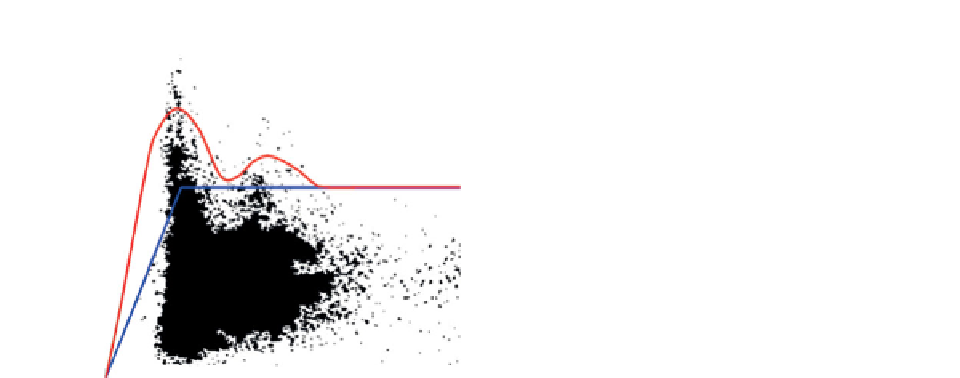Geology Reference
In-Depth Information
with an important initial sense check, and helps in
avoiding the error of predicting actual thickness from
apparent
5000
beds. An example is
shown in
Fig. 10.13
from a gas field with a low-
impedance clean sand reservoir. Two wells have been
drilled. Well K was the discovery well and drilled a
thin (4 m) gas column. Well L subsequently encoun-
tered a 13 m column. The tuning plot (blue points)
was generated from top and base seismic picks and a
tuning curve (generated using the wavelet in the data)
has been scaled to the highest amplitudes on the plot.
With respect to the well K location, a pre-drill error
might be to interpret the seismic thickness as the
actual thickness (i.e. 10 m, whereas the well found
4 m). Scaling the data with a tuning curve, however,
gives a net pay thickness prediction of around 2 m,
assuming that the sand is clean (
Fig. 10.13b
). If the
reservoir is composed of sand and shale layers it is
possible, following the observations of Meckel and
Nath (
1977
) (see
Fig. 5.30
), that the amplitude/net
pay relationship is more linear; in which case the
predicted net pay would have been around 3 m. In
either case the net pay would have been slightly
underestimated as opposed to being severely overesti-
mated. At the location of well L the net pay thickness
would have been calculated pre-drill by taking the
ratio of the trough amplitude to the scaled tuning
curve amplitude and multiplying by the apparent
thickness (i.e. (1500/2250) × 20 ms
thickness in
'
thin
'
4000
3000
2000
1000
0
0 0 0 0 0 0 070
Gross Isochron (ms)
Figure 10.12
Seismic crossplot example of thickness versus
composite amplitude with simple tuning curve (red) and baseline
(blue). Redrawn from Brown et al.(
1986
).
(2) the amplitude scaler varies with apparent
thickness to account for interference effects
(
Chapter 3
).
Sometimes this approach is described as
'
amplitude
de-tuning
'
and effectively provides an approximation
of a
component.
Brown et al.(
1984
,
1986
) introduced a technique
applicable to seismic reflectivity data in which a
simple tuning curve is used as a reference to
'
'
net pay
'
¼
13.4 ms, (13.4
ms/2000) × 1690 m/s
11.3 m), giving a thickness
close to that encountered in the well.
An improvement on the amplitude scaling tech-
nique has been published by Connolly (
2007
). Con-
nolly
¼
the amplitudes (
Fig. 10.12
). The curve may
be based on the wavelet in the data or it may be
approximated by eye from the shape of the distribu-
tion. The tuning curve is positioned on the plot either
to encompass the majority of points or to
de-tune
'
s technique utilizes bandlimited impedance in
the form of coloured inversion, although other
approaches to bandlimited impedance can be used
(
Chapter 5
). The net pay prediction problem is
framed in terms of a net pay equation, modified for
seismic application:
'
'
calibrate
'
to wells. A
baseline, with constant ampli-
tude above tuning thickness and tending to zero
below tuning, is also defined. Tuning effects are then
removed by multiplying each point with the baseline/
tuning curve ratio appropriate for the given apparent
thickness, effectively normalizing the data to the
baseline amplitude. Net sand or net pay can then be
calculated by multiplying the
'
no-tuning
'
Net pay
¼
seismic N
:
G × apparent thickness,
where seismic N:G
¼
average bandlimited impedance
amplitude
map by the apparent thickness. In practice, this tech-
nique tends to overestimate clean sand thickness
below tuning and becomes inappropriate when two
sands close to tuning thickness are present (Simm,
2009
).
Notwithstanding the limitations of amplitude
scaling this type of technique provides the interpreter
'
corrected
'
× scaler.
The method can be understood in relation to a
simple wedge model, calculated using a bandpass
wavelet consistent with the bandlimited impedance
(
Fig. 10.14
). Average bandlimited impedance (ABLI)
and apparent thickness are calculated relative to the
zero crossings associated with the reflections from
top and base of the wedge. Given that the net sand
231















